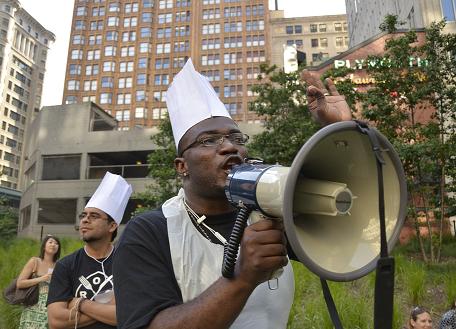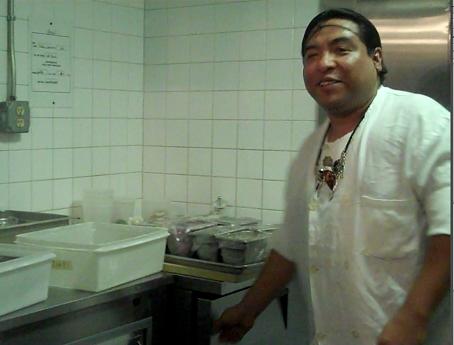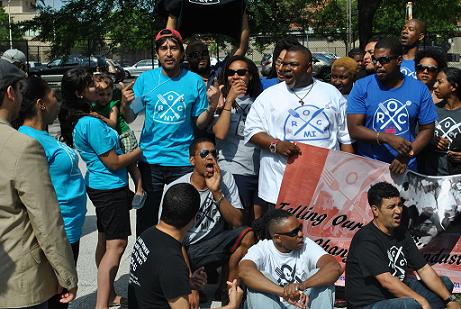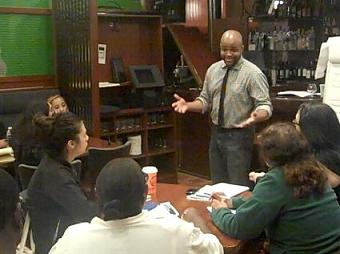
Among the thousands who perished in 9/11 were the 73 mostly immigrant low wage workers who worked at the Upscale restaurant Windows On The World on the top floors of the World Trade Center. The remaining 300+ employees were left without work, along with thousands of other workers in the ground zero area whose restaurants closed from contamination. Some of these workers banded together to form ROC and create work opportunities for the displaced workers with a focus on creating more dignified conditions.
Fekkak Mamdouh, a Moroccan Immigrant is one of the founders of ROC and the current co-director of ROC United. As a survivor of 9/11 and former employee of Windows On the World he has dedicated the past ten years of his life to the legacy of his co-workers. I spoke with Mamdouh at COLORS, the ROC cooperatively run and owned restaurant in lower Manhattan.
“After we started the organization, we thought we have to start this, we have to own a restaurant to be in the memory of the 73 people we lost in 9/11. We wanted a place where the survivors could come and remember them, where the families could come and remember them.”
COLORS opened in 2006 and has 10 co-owners who collectively make decisions about the restaurant’s operation, choose the eclectic menu that is representative of the nationalities of the people who work there, and share in profits. Mamdouh added “It’s perfect, it’s the best thing working in your own place. If you’re a guest all the owners are serving you, we all believe in helping other people.”
In the back of the restaurant you find Mexican immigrants working not just as dishwashers and busboys – low wage positions that they are typically relegated to – but also as chefs and line cooks. Oscar Gallindo from Nezahualcóyotl City, Mexico talks to me about workers rights in the industry as he prepares a quinoa curry salad with upbeat Latin cumbia music plays in the background. Gallindo says he was very depressed in the year following 9/11 as he worked close-by to the World Trade Center and lost his job. He could not find new employment and was also mourning the deaths of all his fellow workers in the area. Once he heard about the organizing work that the former Windows On The World employees were doing, he immediately joined forces with them not just to find employment but also to work against exploitation in the field.

He added that at COLORS they strive to operate a business with “respect and dignity” and to serve as a positive example for the “bad restaurant owners.” He also said in general at restaurants you often find the so called “pretty faces in the front, and the ugly ones in the back.” He is referring to the systemic racism within the restaurant industry in which white workers often fill better paid front end positions in the hospitality business and people of color in the back end. Mamdouh echoed this sentiment and added that in his near 20 years in the restaurant industry he has never once met a white dishwasher.
The Color of Food, a recent report published by the Applied Research Center, confirms Gallindo’s statement and shows how workers of color are highly concentrated in low-wage food service jobs, such as food preparation and fast food. Yvonne Liu was a chief researcher for a report and says they analyzed federal labor data which revealed systematic racism in all four sectors of the food chain, food production, food processing, distribution and food service.
“People of color who work in the food chain make more than $5,000 dollars less per year. As women there is also a gender penalty for workers as well. For every dollar that a white male worker earns in the food chain, a woman of color earns almost half that,” Liu said.
The study also found that white men predominantly fill manager positions and that the lowest wage positions are generally filled by people of color. This report was published in conjunction with the organization Focus on the Food Chain, a network of workers organizing across all sectors of the food chain including the farmworker organization Coalition of Immokalee Workers, food processors Union United Food and Commercial Workers Local 770, ROC United and others.
The research arm of ROC United has also released its own report: “Behind the Kitchen Door: A Multi-site Study of the Restaurant Industry.” Drawing on findings from 4,000 surveys, hundreds of interviews with employers and workers and governmental data they found that less than 22% of restaurant workers make a livable wage and that 87.7% of workers nationwide do not have paid sick days. Racial discrimination was also widely prevalent in their research with the median wage for white workers clocking in at $13.25 compared to $9.54 for workers of color.

Mamdouh said, “We never lose, any campaign we go to. We don’t win because we are strong, we win because we are right. It’s so easy; people get discriminated, if you go to court you’re going to win.”
ROC has also launched policy campaigns advocating for the passage of WAGES, a federal bill that would incrementally raise the minimum tipped wage for waiters and waitresses from $2.13 per hour to $5.50 per hour – or the equivalent of 70% of the minimum wage. Through its research ROC has also discovered that two thirds of restaurant workers reported working while they are sick, because of the widespread absence of paid sick days, and thus have been advocating for the passage of the Healthy Families Act which would give workers up to seven paid sick days yearly. ROC’s policy efforts are also part of their organizing with The Excluded Workers Congress that was formed at the 2010 U.S. Social Forum by workers who are not currently protected under the 1935 National Labor Relations act, which guarantees the right to collectively bargain.

COLORS has been so successful in advancing restaurant workers rights and helping thousands of people receive training in the industry, that it has spawned other restaurants. On September 12th, a new COLORS restaurant will open in Detroit. The city of Detroit with its struggling economy has been long been considered a “food desert” where fast food and snack food is abundant and grocery stores with fresh produce are scarce. Many food justice activists in Detroit have started urban farms to address this need and the new COLORS, according to the manager Phil Jones, hopes to carry 80% locally-sourced food from these urban farms and others in the area.
“We want to show people that there is a model out there for treating workers properly, for putting out good products, for expanding your local food economy and strengthening food systems in general – even down to creating healthier food access,” said Jones.
ROC members said that their model for building workplace justice through training, cooperative ownership and leading campaigns within restaurants who are disrespecting workers has drawn international attention. Mamdouh says people in Europe, Asia and Latin America have contacted them about starting similar organizations in their countries, and ROC members hope the movement to create a more dignified industry will continue to spread and grow over the next ten years.
Andalusia Knoll is a multimedia journalist, popular educator and organizer. She is a a program director with Brooklyn based VibeGirls Radio, a producer with the national Criminal Justice Dialogue Project Thousand Kites, and a freelance journalist who has reported for various news outlets including Democracy Now! Free Speech Radio News, and TeleSUR. She is in love with that little box of technology known as the radio and has conducted bilingual radio and video trainings with youth and social justice organizations across the United States and Latin America. When she’s not writing, producing or teaching radio you can catch her organizing with the Coalition of Immokalee Workers or riding her bike on the streets of Brooklyn.
